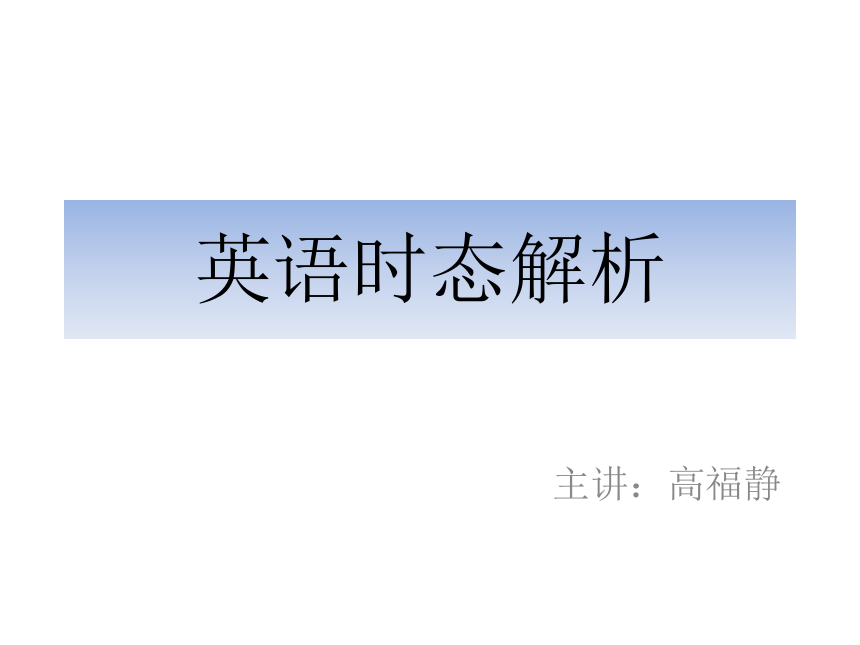
英语时态解析 主讲:高福静 时态是谓语动词的形式,表示动作发生的时间或所处的状态,是由动词的不同形式来表现的,这就是动词的时态。 英语时态共有16种,常考的有10种: 状态 时间 一般 进行 完成 现在 S。+be +表语 S. +V. +O. S. + be doing +O. S. + have/has +done 将来 S. +will +V. +O. S. +will be doing +O. S. +will have done 过去 S. +did /was/were+… S. +was/were doing S. + had done 完成进行时 Have been doing Will have been doing Had been doing 过去将来 Would do sth. Would be doing sth. Would have done Would have been doing 一般现在时 定义 结构 标志词 用法 练习 【定 义】 一般现在时表示现在经常反复发生的动作、存在的状态或习惯性的动作。即描述我们日常生活中的衣食住行等活动。 结构: Be 动词:She’s a worker. Is she a worker? She isn’t a worker. 情态动词:I can play the piano. Can you play the piano? I can’t play the piano. 行为动词:They want to eat some tomatoes. Do they want to eat any tomatoes? They don’t want to eat any tomatoes. Gina has a nice watch. Does Gina have a nice watch? Gina doesn’t have a watch. 变形: 肯定句: 主语+ be+ 其它。 否定句: 主语+ be+not + 其它。 一般问句: Be+主语+ 其它, 特殊疑问句: 特殊疑问词+be+主语+其它, 含实义动词的一般现在时结构: 肯定句:主语+动词原形/动词三单形式+其它。 否定句:主语+don’t/doesn’t+动词原形+其它。 一般问句: Do/Does+主语+动词原形+其它, 特殊疑问句: 特殊疑问词+do/does+主语+动词原形+其它, ?句式 ?结构 ?例句 肯定句 ?主语+行为动词原形+其他 ?We speak Chinese. ?否定句 ?主语+don’t+行为动词 原形+其他 ?We don’t speak Chinese. ?一般疑问句 ?Do+主语+行为动词原 形+其他? ?Do you speak Chinese? ?肯定回答 ?Yes,主语+do ?Yes, we do. 否定回答 No,主语+don’t No, we don’t. 标志词: 时间状语与时态有着极为密切的关系,以下常与各种时态连用的时间状语:常与表频度的adv.或时间状语连用。 always, usually, often, frequently, seldom,sometimes, occasionally,every day, once a week etc. 2. 有些句子没有明显的时间状语,这时就可以根据上下文内容来判断时间关系,确定正确的时态。 She lives in the city, but she doesn’t like the life in the city. 1. 表示现在的状态或经常性的动作: The boy is ill.这男孩病了We need a lot of money. 我们需要大笔钱。He gets up at six every day. 他每天六点起床。 2. 表示现在的能力、特征、职业等:She dances well. 她跳舞跳得好。My father teaches physics. 我父亲教物理。 3. 表示普遍真理或客观事实: Summer follows spring. 春去夏来。 A plane is faster than a car. The earth turns around the sun. 地球绕着太阳转。 即使是在主句为过去时态的宾语从句中,表示客观真理的句也用一般现在时态: The teacher told us that the earth turns around the sun. Columbus proved that the earth is round. As the saying goes, it is the early bird that catches the worm. 用法 4)表示人的心理活动和感官动作通常用一般现在时,常见动词有:like, love, hate, dislike, want, wish, hope, think, understand, remember, forget, mean, need, hear, feel, see e.g. He really hopes you can enjoy your stay here. I: 一般现在时代替进行时 用法:在某些习惯性表达法中,一般现在时可以用来表示现正在发生的动作或存在的状态 e.g. 车来了。 Here comes the bus! = The bus is coming. There goe ... ...
~~ 您好,已阅读到文档的结尾了 ~~

